很多人一提到锁,自然第一个想到了synchronized,但一直不懂源码实现,现特地追踪到C++层来剥开synchronized的面纱。
网上的很多描述大都不全,让人看了不够爽,看完本章,你将彻底了解synchronized的核心原理。
一、启蒙知识预热
开启本文之前先介绍2个概念
1.1.cas操作
为了提高性能,JVM很多操作都依赖CAS实现,一种乐观锁的实现。本文锁优化中大量用到了CAS,故有必要先分析一下CAS的实现。
CAS:Compare and Swap。
JNI来完成CPU指令的操作:
unsafe.compareAndSwapInt(this, valueOffset, expect, update);
CAS有3个操作数,内存值V,旧的预期值A,要修改的新值B。如果A=V,那么把B赋值给V,返回V;如果A!=V,直接返回V。
打开源码:openjdk\hotspot\src\oscpu\windowsx86\vm\ atomicwindowsx86.inline.hpp,如下图:0
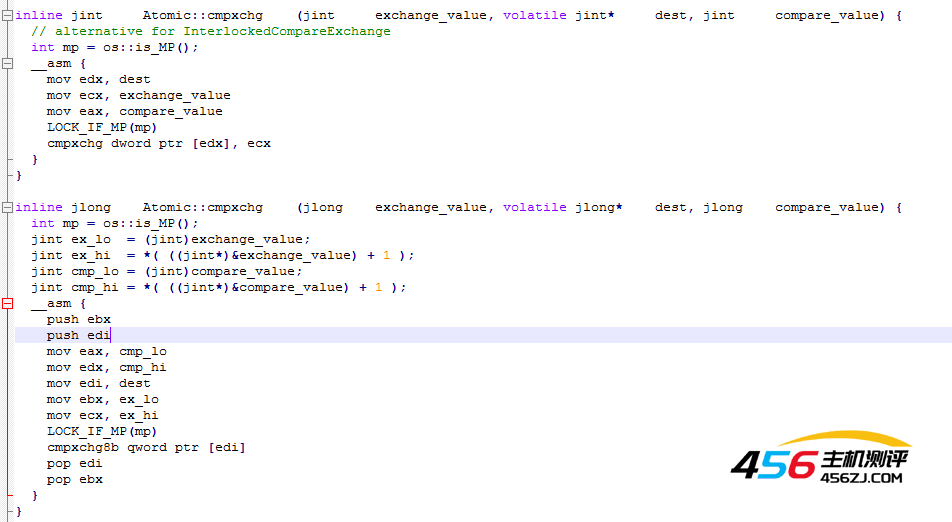
os::is_MP() 这个是runtime/os.hpp,实际就是返回是否多处理器,源码如下:

如上面源代码所示(看第一个int参数即可),LOCK_IF_MP:会根据当前处理器的类型来决定是否为cmpxchg指令添加lock前缀。如果程序是在多处理器上运行,就为cmpxchg指令加上lock前缀(lock cmpxchg)。反之,如果程序是在单处理器上运行,就省略lock前缀(单处理器自身会维护单处理器内的顺序一致性,不需要lock前缀提供的内存屏障效果)。
1.2.对象头
HotSpot虚拟机中,对象在内存中存储的布局可以分为三块区域:对象头(Header)、实例数据(Instance Data)和对齐填充(Padding)。
HotSpot虚拟机的对象头(Object Header)包括两部分信息:
第一部分"mark Word":用于存储对象自身的运行时数据, 如哈希码(HashCode)、GC分代年龄、锁状态标志、线程持有的锁、偏向线程ID、偏向时间戳等等.
第二部分"Klass Pointer":对象指向它的类的元数据的指针,虚拟机通过这个指针来确定这个对象是哪个类的实例。(数组,对象头中还必须有一块用于记录数组长度的数据,因为虚拟机可以通过普通Java对象的元数据信息确定Java对象的大小,但是从数组的元数据中无法确定数组的大小。 )
32位的HotSpot虚拟机对象头存储结构:(下图摘自网络)
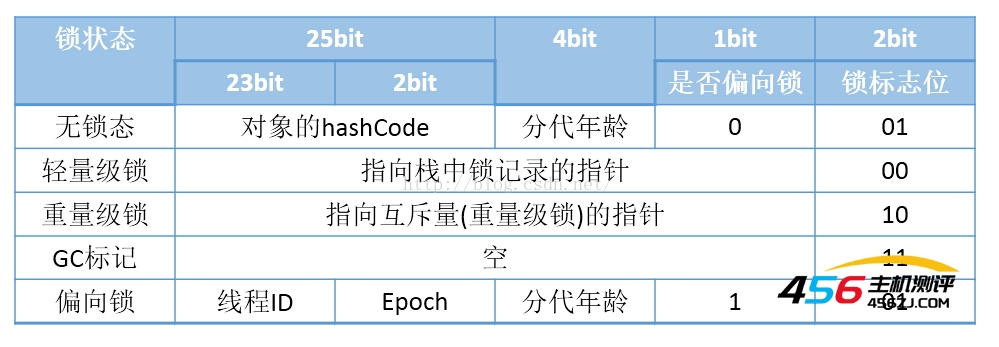
图1 32位的HotSpot虚拟机对象头Mark Word组成
为了证实上图的正确性,这里我们看openJDK--》hotspot源码markOop.hpp,虚拟机对象头存储结构:
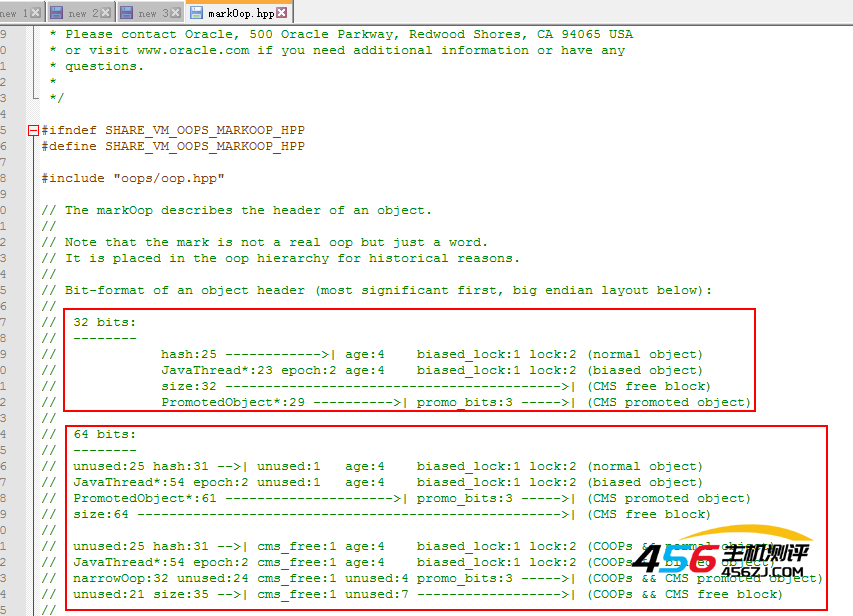
图2 HotSpot源码markOop.hpp中注释
单词解释:
hash: 保存对象的哈希码
age: 保存对象的分代年龄
biased_lock: 偏向锁标识位
lock: 锁状态标识位
JavaThread*: 保存持有偏向锁的线程ID
epoch: 保存偏向时间戳
上图中有源码中对锁标志位这样枚举:
1 enum { locked_value = 0,//00 轻量级锁 2 unlocked_value = 1,//01 无锁 3 monitor_value = 2,//10 监视器锁,也叫膨胀锁,也叫重量级锁 4 marked_value = 3,//11 GC标记 5 biased_lock_pattern = 5 //101 偏向锁 6 };
下面是源码注释:

图3 HotSpot源码markOop.hpp中锁标志位注释
看图3,不管是32/64位JVM,都是1bit偏向锁+2bit锁标志位。上面红框是偏向锁(第一行是指向线程的显示偏向锁,第二行是匿名偏向锁)对应枚举biased_lock_pattern,下面红框是轻量级锁、无锁、监视器锁、GC标记,分别对应上面的前4种枚举。我们甚至能看见锁标志11时,是GC的markSweep(标记清除算法)使用的。(这里就不再拓展了)
对象头中的Mark Word,synchronized源码实现就用了Mark Word来标识对象加锁状态。
二、JVM中synchronized锁实现原理(优化)
大家都知道java中锁synchronized性能较差,线程会阻塞。本节将以图文形式来描述JVM的synchronized锁优化。
在jdk1.6中对锁的实现引入了大量的优化来减少锁操作的开销:
锁粗化(Lock Coarsening):将多个连续的锁扩展成一个范围更大的锁,用以减少频繁互斥同步导致的性能损耗。 锁消除(Lock Elimination):JVM及时编译器在运行时,通过逃逸分析,如果判断一段代码中,堆上的所有数据不会逃逸出去从来被其他线程访问到,就可以去除这些锁。 轻量级锁(Lightweight Locking):JDK1.6引入。在没有多线程竞争的情况下避免重量级互斥锁,只需要依靠一条CAS原子指令就可以完成锁的获取及释放。 偏向锁(Biased Locking):JDK1.6引入。目的是消除数据再无竞争情况下的同步原语。使用CAS记录获取它的线程。下一次同一个线程进入则偏向该线程,无需任何同步操作。 适应性自旋(Adaptive Spinning):为了避免线程频繁挂起、恢复的状态切换消耗。产生了忙循环(循环时间固定),即自旋。JDK1.6引入了自适应自旋。自旋时间根据之前锁自旋时间和线程状态,动态变化,用以期望能减少阻塞的时间。
锁升级:偏向锁--》轻量级锁--》重量级锁
2.1.偏向锁
按照之前的HotSpot设计,每次加锁/解锁都会涉及到一些CAS操作(比如对等待队列的CAS操作),CAS操作会延迟本地调用,因此偏向锁的想法是一旦线程第一次获得了监视对象,之后让监视对象“偏向”这个线程,之后的多次调用则可以避免CAS操作。
简单的讲,就是在锁对象的对象头(开篇讲的对象头数据存储结构)中有个ThreaddId字段,这个字段如果是空的,第一次获取锁的时候,就将自身的ThreadId写入到锁的ThreadId字段内,将锁头内的是否偏向锁的状态位置1.这样下次获取锁的时候,直接检查ThreadId是否和自身线程Id一致,如果一致,则认为当前线程已经获取了锁,因此不需再次获取锁,略过了轻量级锁和重量级锁的加锁阶段。提高了效率。
注意:当锁有竞争关系的时候,需要解除偏向锁,进入轻量级锁。
每一个线程在准备获取共享资源时:
第一步,检查MarkWord里面是不是放的自己的ThreadId ,如果是,表示当前线程是处于 “偏向锁”.跳过轻量级锁直接执行同步体。
获得偏向锁如下图:
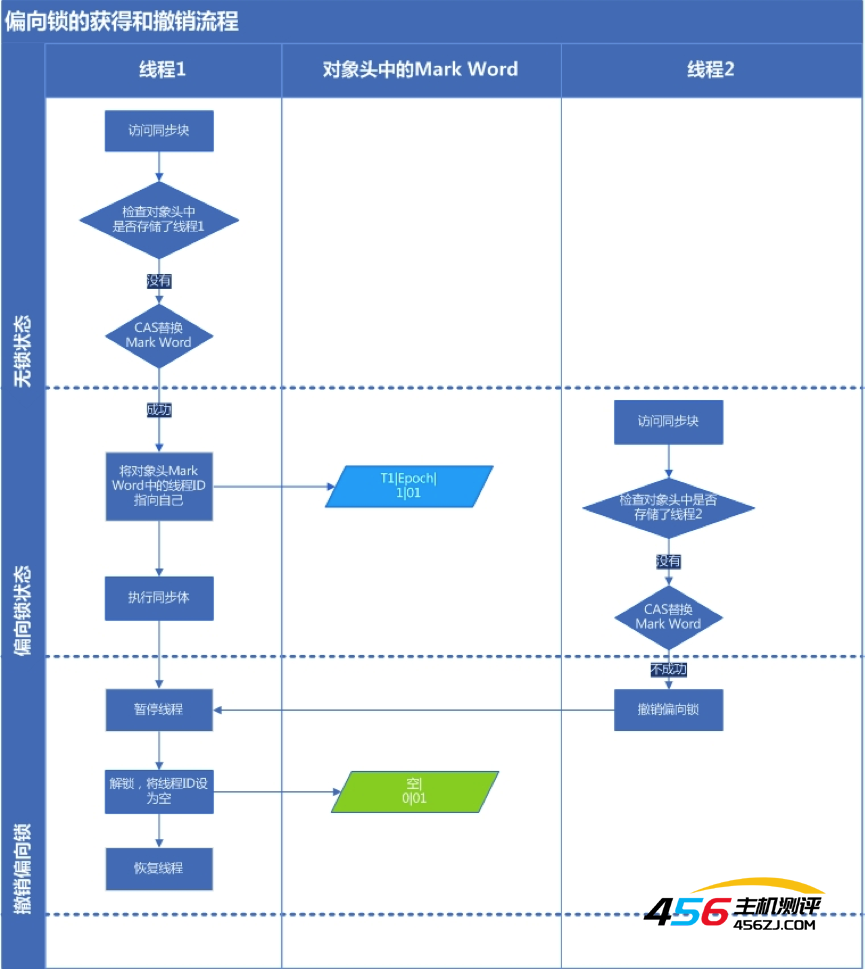
2.2.轻量级锁和重量级锁
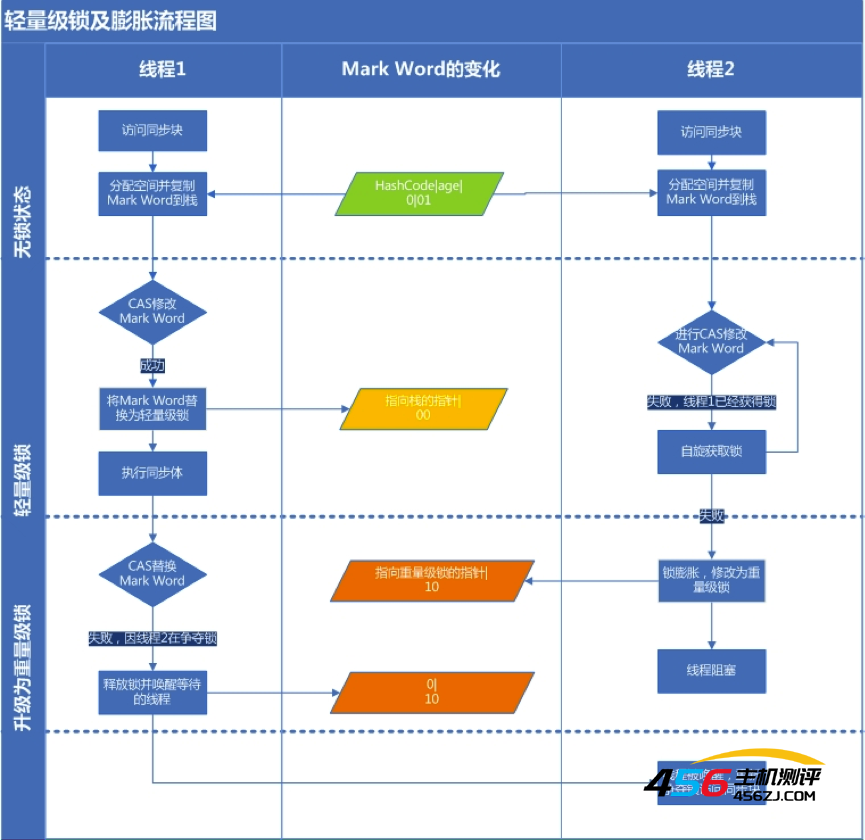
如上图所示:
第二步,如果MarkWord不是自己的ThreadId,锁升级,这时候,用CAS来执行切换,新的线程根据MarkWord里面现有的ThreadId,通知之前线程暂停,之前线程将Markword的内容置为空。
第三步,两个线程都把对象的HashCode复制到自己新建的用于存储锁的记录空间,接着开始通过CAS操作,把共享对象的MarKword的内容修改为自己新建的记录空间的地址的方式竞争MarkWord.
第四步,第三步中成功执行CAS的获得资源,失败的则进入自旋.
第五步,自旋的线程在自旋过程中,成功获得资源(即之前获的资源的线程执行完成并释放了共享资源),则整个状态依然处于轻量级锁的状态,如果自旋失败 第六步,进入重量级锁的状态,这个时候,自旋的线程进行阻塞,等待之前线程执行完成并唤醒自己.
注意点:JVM加锁流程
偏向锁--》轻量级锁--》重量级锁
从左往右可以升级,从右往左不能降级
三、从C++源码看synchronized
前两节讲了synchronized锁实现原理,这一节我们从C++源码来剖析synchronized。
3.1 同步和互斥
同步:多个线程并发访问共享资源时,保证同一时刻只有一个(信号量可以多个)线程使用。
实现同步的方法有很多,常见四种如下:
1)临界区(CriticalSection,又叫关键段):通过对多线程的串行化来访问公共资源或一段代码,速度快,适合控制数据访问。进程内可用。
2)互斥量:互斥量用于线程的互斥。只能为0/1。一个互斥量只能用于一个资源的互斥访问,可跨进程使用。
3)信号量:信号线用于线程的同步。可以为非负整数,可实现多个同类资源的多线程互斥和同步。当信号量为单值信号量是,也可以完成一个资源的互斥访问。可跨进程使用。
4)事件:用来通知线程有一些事件已发生,从而启动后继任务的开始,可跨进程使用。
synchronized的底层实现就用到了临界区和互斥锁(重量级锁的情况下)这两个概念。
3.2 synchronized C++源码
重点来了,之前在第一节中的图1,看过了对象头Mark Word。现在我们从C++源码来剖析具体的数据结构和获取释放锁的过程。
2.2.1 C++中的监视器锁数据结构
oopDesc--继承-->markOopDesc--方法monitor()-->ObjectMonitor-->enter、exit 获取、释放锁
1.oopDesc类
openjdk\hotspot\src\share\vm\oops\oop.hpp下oopDesc类是JVM对象的顶级基类,故每个object都包含markOop。如下图所示:
1 class oopDesc { 2 friend class VMStructs; 3 private: 4 volatile markOop _mark;//markOop:Mark Word标记字段 5 union _metadata { 6 Klass* _klass;//对象类型元数据的指针 7 narrowKlass _compressed_klass; 8 } _metadata; 9 10 // Fast access to barrier set. Must be initialized. 11 static BarrierSet* _bs; 12 13 public: 14 markOop mark() const { return _mark; } 15 markOop* mark_addr() const { return (markOop*) &_mark; } 16 17 void set_mark(volatile markOop m) { _mark = m; } 18 19 void release_set_mark(markOop m); 20 markOop cas_set_mark(markOop new_mark, markOop old_mark); 21 22 // Used only to re-initialize the mark word (e.g., of promoted 23 // objects during a GC) -- requires a valid klass pointer 24 void init_mark(); 25 26 Klass* klass() const; 27 Klass* klass_or_null() const volatile; 28 Klass** klass_addr(); 29 narrowKlass* compressed_klass_addr();
....省略...
}
2.markOopDesc类
openjdk\hotspot\src\share\vm\oops\markOop.hpp下markOopDesc继承自oopDesc,并拓展了自己的方法monitor(),如下图
1 ObjectMonitor* monitor() const { 2 assert(has_monitor(), "check"); 3 // Use xor instead of &~ to provide one extra tag-bit check. 4 return (ObjectMonitor*) (value() ^ monitor_value); 5 }
该方法返回一个ObjectMonitor*对象指针。
其中value()这样定义:
1 uintptr_t value() const { return (uintptr_t) this; }
可知:将this转换成一个指针宽度的整数(uintptr_t),然后进行"异或"位操作。
monitor_value是常量
1 enum { locked_value = 0,//00轻量级锁 2 unlocked_value = 1,//01无锁 3 monitor_value = 2,//10监视器锁,又叫重量级锁 4 marked_value = 3,//11GC标记 5 biased_lock_pattern = 5 //101偏向锁 6 };
指针低2位00,异或10,结果还是10.(拿一个模板为00的数,异或一个二位数=数本身。因为异或:“相同为0,不同为1”.操作)
3.ObjectMonitor类
在HotSpot虚拟机中,最终采用ObjectMonitor类实现monitor。
openjdk\hotspot\src\share\vm\runtime\objectMonitor.hpp源码如下:
1 ObjectMonitor() { 2 _header = NULL;//markOop对象头 3 _count = 0; 4 _waiters = 0,//等待线程数 5 _recursions = 0;//重入次数 6 _object = NULL;//监视器锁寄生的对象。锁不是平白出现的,而是寄托存储于对象中。 7 _owner = NULL;//指向获得ObjectMonitor对象的线程或基础锁 8 _WaitSet = NULL;//处于wait状态的线程,会被加入到wait set; 9 _WaitSetLock = 0 ; 10 _Responsible = NULL ; 11 _succ = NULL ; 12 _cxq = NULL ; 13 FreeNext = NULL ; 14 _EntryList = NULL ;//处于等待锁block状态的线程,会被加入到entry set; 15 _SpinFreq = 0 ; 16 _SpinClock = 0 ; 17 OwnerIsThread = 0 ;// _owner is (Thread *) vs SP/BasicLock 18 _previous_owner_tid = 0;// 监视器前一个拥有者线程的ID 19 }
每个线程都有两个ObjectMonitor对象列表,分别为free和used列表,如果当前free列表为空,线程将向全局global list请求分配ObjectMonitor。
ObjectMonitor对象中有两个队列:_WaitSet 和 _EntryList,用来保存ObjectWaiter对象列表;
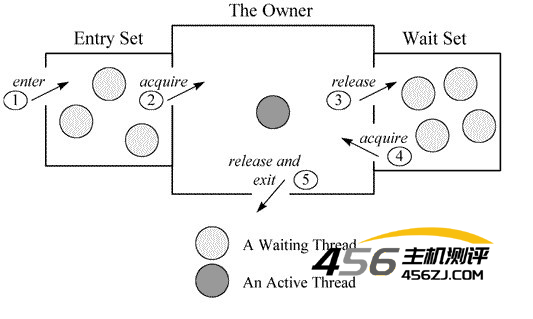
2.获取锁流程
synchronized关键字修饰的代码段,在JVM被编译为monitorenter、monitorexit指令来获取和释放互斥锁.。
解释器执行monitorenter时会进入到InterpreterRuntime.cpp的InterpreterRuntime::monitorenter函数,具体实现如下:
1 IRT_ENTRY_NO_ASYNC(void, InterpreterRuntime::monitorenter(JavaThread* thread, BasicObjectLock* elem)) 2 #ifdef ASSERT 3 thread->last_frame().interpreter_frame_verify_monitor(elem); 4 #endif 5 if (PrintBiasedLockingStatistics) { 6 Atomic::inc(BiasedLocking::slow_path_entry_count_addr()); 7 } 8 Handle h_obj(thread, elem->obj()); 9 assert(Universe::heap()->is_in_reserved_or_null(h_obj()), 10 "must be NULL or an object"); 11 if (UseBiasedLocking) {//标识虚拟机是否开启偏向锁功能,默认开启 12 // Retry fast entry if bias is revoked to avoid unnecessary inflation 13 ObjectSynchronizer::fast_enter(h_obj, elem->lock(), true, CHECK); 14 } else { 15 ObjectSynchronizer::slow_enter(h_obj, elem->lock(), CHECK); 16 } 17 assert(Universe::heap()->is_in_reserved_or_null(elem->obj()), 18 "must be NULL or an object"); 19 #ifdef ASSERT 20 thread->last_frame().interpreter_frame_verify_monitor(elem); 21 #endif 22 IRT_END
先看一下入参:
1、JavaThread thread指向java中的当前线程;
2、BasicObjectLock基础对象锁:包含一个BasicLock和一个指向Object对象的指针oop。
openjdk\hotspot\src\share\vm\runtime\basicLock.hpp中BasicObjectLock类源码如下:
1 class BasicObjectLock VALUE_OBJ_CLASS_SPEC { 2 friend class VMStructs; 3 private: 4 BasicLock _lock; // the lock, must be double word aligned 5 oop _obj; // object holds the lock; 6 7 public: 8 // Manipulation 9 oop obj() const { return _obj; } 10 void set_obj(oop obj) { _obj = obj; } 11 BasicLock* lock() { return &_lock; } 12 13 // Note: Use frame::interpreter_frame_monitor_size() for the size of BasicObjectLocks 14 // in interpreter activation frames since it includes machine-specific padding. 15 static int size() { return sizeof(BasicObjectLock)/wordSize; } 16 17 // GC support 18 void oops_do(OopClosure* f) { f->do_oop(&_obj); } 19 20 static int obj_offset_in_bytes() { return offset_of(BasicObjectLock, _obj); } 21 static int lock_offset_in_bytes() { return offset_of(BasicObjectLock, _lock); } 22 };
3、BasicLock类型_lock对象主要用来保存:指向Object对象的对象头数据;
basicLock.hpp中BasicLock源码如下:
1 class BasicLock VALUE_OBJ_CLASS_SPEC { 2 friend class VMStructs; 3 private: 4 volatile markOop _displaced_header;//markOop是不是很熟悉?1.2节中讲解对象头时就是分析的markOop源码 5 public: 6 markOop displaced_header() const { return _displaced_header; } 7 void set_displaced_header(markOop header) { _displaced_header = header; } 8 9 void print_on(outputStream* st) const; 10 11 // move a basic lock (used during deoptimization 12 void move_to(oop obj, BasicLock* dest); 13 14 static int displaced_header_offset_in_bytes() { return offset_of(BasicLock, _displaced_header); } 15 };
偏向锁的获取ObjectSynchronizer::fast_enter
在HotSpot中,偏向锁的入口位于openjdk\hotspot\src\share\vm\runtime\synchronizer.cpp文件的ObjectSynchronizer::fast_enter函数:
1 void ObjectSynchronizer::fast_enter(Handle obj, BasicLock* lock, bool attempt_rebias, TRAPS) { 2 if (UseBiasedLocking) { 3 if (!SafepointSynchronize::is_at_safepoint()) { 4 BiasedLocking::Condition cond = BiasedLocking::revoke_and_rebias(obj, attempt_rebias, THREAD); 5 if (cond == BiasedLocking::BIAS_REVOKED_AND_REBIASED) { 6 return; 7 } 8 } else { 9 assert(!attempt_rebias, "can not rebias toward VM thread"); 10 BiasedLocking::revoke_at_safepoint(obj); 11 } 12 assert(!obj->mark()->has_bias_pattern(), "biases should be revoked by now"); 13 } 14 //轻量级锁
偏向锁的获取由BiasedLocking::revoke_and_rebias方法实现,由于实现比较长,就不贴代码了,实现逻辑如下:
1、通过markOop mark = obj->mark()获取对象的markOop数据mark,即对象头的Mark Word;
2、判断mark是否为可偏向状态,即mark的偏向锁标志位为 1,锁标志位为 01;
3、判断mark中JavaThread的状态:如果为空,则进入步骤(4);如果指向当前线程,则执行同步代码块;如果指向其它线程,进入步骤(5);
4、通过CAS原子指令设置mark中JavaThread为当前线程ID,如果执行CAS成功,则执行同步代码块,否则进入步骤(5);
5、如果执行CAS失败,表示当前存在多个线程竞争锁,当达到全局安全点(safepoint),获得偏向锁的线程被挂起,撤销偏向锁,并升级为轻量级,升级完成后被阻塞在安全点的线程继续执行同步代码块;
偏向锁的撤销
只有当其它线程尝试竞争偏向锁时,持有偏向锁的线程才会释放锁,偏向锁的撤销由BiasedLocking::revoke_at_safepoint方法实现:
1 void BiasedLocking::revoke_at_safepoint(Handle h_obj) { 2 assert(SafepointSynchronize::is_at_safepoint(), "must only be called while at safepoint");//校验全局安全点 3 oop obj = h_obj(); 4 HeuristicsResult heuristics = update_heuristics(obj, false); 5 if (heuristics == HR_SINGLE_REVOKE) { 6 revoke_bias(obj, false, false, NULL); 7 } else if ((heuristics == HR_BULK_REBIAS) || 8 (heuristics == HR_BULK_REVOKE)) { 9 bulk_revoke_or_rebias_at_safepoint(obj, (heuristics == HR_BULK_REBIAS), false, NULL); 10 } 11 clean_up_cached_monitor_info(); 12 }
1、偏向锁的撤销动作必须等待全局安全点;
2、暂停拥有偏向锁的线程,判断锁对象是否处于被锁定状态;
3、撤销偏向锁,恢复到无锁(标志位为 01)或轻量级锁(标志位为 00)的状态;
偏向锁在Java 1.6之后是默认启用的,但在应用程序启动几秒钟之后才激活,可以使用-XX:BiasedLockingStartupDelay=0参数关闭延迟,如果确定应用程序中所有锁通常情况下处于竞争状态,可以通过XX:-UseBiasedLocking=false参数关闭偏向锁。
轻量级锁的获取
轻量级锁的获取当关闭偏向锁功能,或多个线程竞争偏向锁导致偏向锁升级为轻量级锁,会尝试获取轻量级锁,其入口位于
ObjectSynchronizer::slow_enter
1 void ObjectSynchronizer::slow_enter(Handle obj, BasicLock* lock, TRAPS) { 2 markOop mark = obj->mark(); 3 assert(!mark->has_bias_pattern(), "should not see bias pattern here"); 4 5 if (mark->is_neutral()) {//是否为无锁状态001 6 // Anticipate successful CAS -- the ST of the displaced mark must 7 // be visible <= the ST performed by the CAS. 8 lock->set_displaced_header(mark); 9 if (mark == (markOop) Atomic::cmpxchg_ptr(lock, obj()->mark_addr(), mark)) {//CAS成功,释放栈锁 10 TEVENT (slow_enter: release stacklock) ; 11 return ; 12 } 13 // Fall through to inflate() ... 14 } else 15 if (mark->has_locker() && THREAD->is_lock_owned((address)mark->locker())) { 16 assert(lock != mark->locker(), "must not re-lock the same lock"); 17 assert(lock != (BasicLock*)obj->mark(), "don't relock with same BasicLock"); 18 lock->set_displaced_header(NULL); 19 return; 20 } 21 22 #if 0 23 // The following optimization isn't particularly useful. 24 if (mark->has_monitor() && mark->monitor()->is_entered(THREAD)) { 25 lock->set_displaced_header (NULL) ; 26 return ; 27 } 28 #endif 29 30 // The object header will never be displaced to this lock, 31 // so it does not matter what the value is, except that it 32 // must be non-zero to avoid looking like a re-entrant lock, 33 // and must not look locked either. 34 lock->set_displaced_header(markOopDesc::unused_mark()); 35 ObjectSynchronizer::inflate(THREAD, obj())->enter(THREAD); 36 }
1、markOop mark = obj->mark()方法获取对象的markOop数据mark;
2、mark->is_neutral()方法判断mark是否为无锁状态:mark的偏向锁标志位为 0,锁标志位为 01;
3、如果mark处于无锁状态,则进入步骤(4),否则执行步骤(6);
4、把mark保存到BasicLock对象的_displaced_header字段;
5、通过CAS尝试将Mark Word更新为指向BasicLock对象的指针,如果更新成功,表示竞争到锁,则执行同步代码,否则执行步骤(6);
6、如果当前mark处于加锁状态,且mark中的ptr指针指向当前线程的栈帧,则执行同步代码,否则说明有多个线程竞争轻量级锁,轻量级锁需要膨胀升级为重量级锁;
假设线程A和B同时执行到临界区if (mark->is_neutral()):
1、线程AB都把Mark Word复制到各自的_displaced_header字段,该数据保存在线程的栈帧上,是线程私有的;
2、Atomic::cmpxchg_ptr原子操作保证只有一个线程可以把指向栈帧的指针复制到Mark Word,假设此时线程A执行成功,并返回继续执行同步代码块;
3、线程B执行失败,退出临界区,通过ObjectSynchronizer::inflate方法开始膨胀锁;
轻量级锁的释放
轻量级锁的释放通过ObjectSynchronizer::slow_exit--->调用
ObjectSynchronizer::fast_exit
完成。
1 void ObjectSynchronizer::fast_exit(oop object, BasicLock* lock, TRAPS) { 2 assert(!object->mark()->has_bias_pattern(), "should not see bias pattern here"); 3 // if displaced header is null, the previous enter is recursive enter, no-op 4 markOop dhw = lock->displaced_header(); 5 markOop mark ; 6 if (dhw == NULL) { 7 // Recursive stack-lock. 8 // Diagnostics -- Could be: stack-locked, inflating, inflated. 9 mark = object->mark() ; 10 assert (!mark->is_neutral(), "invariant") ; 11 if (mark->has_locker() && mark != markOopDesc::INFLATING()) { 12 assert(THREAD->is_lock_owned((address)mark->locker()), "invariant") ; 13 } 14 if (mark->has_monitor()) { 15 ObjectMonitor * m = mark->monitor() ; 16 assert(((oop)(m->object()))->mark() == mark, "invariant") ; 17 assert(m->is_entered(THREAD), "invariant") ; 18 } 19 return ; 20 } 21 22 mark = object->mark() ; 23 24 // If the object is stack-locked by the current thread, try to 25 // swing the displaced header from the box back to the mark. 26 if (mark == (markOop) lock) { 27 assert (dhw->is_neutral(), "invariant") ; 28 if ((markOop) Atomic::cmpxchg_ptr (dhw, object->mark_addr(), mark) == mark) {//成功的释放了锁 29 TEVENT (fast_exit: release stacklock) ; 30 return; 31 } 32 } 33 34 ObjectSynchronizer::inflate(THREAD, object)->exit (true, THREAD) ;//锁膨胀升级 35 }
1、确保处于偏向锁状态时不会执行这段逻辑;
2、取出在获取轻量级锁时保存在BasicLock对象的mark数据dhw;
3、通过CAS尝试把dhw替换到当前的Mark Word,如果CAS成功,说明成功的释放了锁,否则执行步骤(4);
4、如果CAS失败,说明有其它线程在尝试获取该锁,这时需要将该锁升级为重量级锁,并释放;
重量级锁
重量级锁通过对象内部的监视器(monitor)实现,其中monitor的本质是依赖于底层操作系统的Mutex Lock实现,操作系统实现线程之间的切换需要从用户态到内核态的切换,切换成本非常高。
锁膨胀过程
锁的膨胀过程通过ObjectSynchronizer::inflate函数实现
1 ObjectMonitor * ATTR ObjectSynchronizer::inflate (Thread * Self, oop object) { 2 // Inflate mutates the heap ... 3 // Relaxing assertion for bug 6320749. 4 assert (Universe::verify_in_progress() || 5 !SafepointSynchronize::is_at_safepoint(), "invariant") ; 6 7 for (;;) {//自旋 8 const markOop mark = object->mark() ; 9 assert (!mark->has_bias_pattern(), "invariant") ; 10 11 // The mark can be in one of the following states: 12 // * Inflated - just return 13 // * Stack-locked - coerce it to inflated 14 // * INFLATING - busy wait for conversion to complete 15 // * Neutral - aggressively inflate the object. 16 // * BIASED - Illegal. We should never see this 17 18 // CASE: inflated已膨胀,即重量级锁 19 if (mark->has_monitor()) {//判断当前是否为重量级锁 20 ObjectMonitor * inf = mark->monitor() ;//获取指向ObjectMonitor的指针 21 assert (inf->header()->is_neutral(), "invariant"); 22 assert (inf->object() == object, "invariant") ; 23 assert (ObjectSynchronizer::verify_objmon_isinpool(inf), "monitor is invalid"); 24 return inf ; 25 } 26 27 // CASE: inflation in progress - inflating over a stack-lock.膨胀等待(其他线程正在从轻量级锁转为膨胀锁) 28 // Some other thread is converting from stack-locked to inflated. 29 // Only that thread can complete inflation -- other threads must wait. 30 // The INFLATING value is transient. 31 // Currently, we spin/yield/park and poll the markword, waiting for inflation to finish. 32 // We could always eliminate polling by parking the thread on some auxiliary list. 33 if (mark == markOopDesc::INFLATING()) { 34 TEVENT (Inflate: spin while INFLATING) ; 35 ReadStableMark(object) ; 36 continue ; 37 } 38 39 // CASE: stack-locked栈锁(轻量级锁) 40 // Could be stack-locked either by this thread or by some other thread. 41 // 42 // Note that we allocate the objectmonitor speculatively, _before_ attempting 43 // to install INFLATING into the mark word. We originally installed INFLATING, 44 // allocated the objectmonitor, and then finally STed the address of the 45 // objectmonitor into the mark. This was correct, but artificially lengthened 46 // the interval in which INFLATED appeared in the mark, thus increasing 47 // the odds of inflation contention. 48 // 49 // We now use per-thread private objectmonitor free lists. 50 // These list are reprovisioned from the global free list outside the 51 // critical INFLATING...ST interval. A thread can transfer 52 // multiple objectmonitors en-mass from the global free list to its local free list. 53 // This reduces coherency traffic and lock contention on the global free list. 54 // Using such local free lists, it doesn't matter if the omAlloc() call appears 55 // before or after the CAS(INFLATING) operation. 56 // See the comments in omAlloc(). 57 58 if (mark->has_locker()) { 59 ObjectMonitor * m = omAlloc (Self) ;//获取一个可用的ObjectMonitor 60 // Optimistically prepare the objectmonitor - anticipate successful CAS 61 // We do this before the CAS in order to minimize the length of time 62 // in which INFLATING appears in the mark. 63 m->Recycle(); 64 m->_Responsible = NULL ; 65 m->OwnerIsThread = 0 ; 66 m->_recursions = 0 ; 67 m->_SpinDuration = ObjectMonitor::Knob_SpinLimit ; // Consider: maintain by type/class 68 69 markOop cmp = (markOop) Atomic::cmpxchg_ptr (markOopDesc::INFLATING(), object->mark_addr(), mark) ; 70 if (cmp != mark) {//CAS失败//CAS失败,说明冲突了,自旋等待//CAS失败,说明冲突了,自旋等待//CAS失败,说明冲突了,自旋等待 71 omRelease (Self, m, true) ;//释放监视器锁 72 continue ; // Interference -- just retry 73 } 74 75 // We've successfully installed INFLATING (0) into the mark-word. 76 // This is the only case where 0 will appear in a mark-work. 77 // Only the singular thread that successfully swings the mark-word 78 // to 0 can perform (or more precisely, complete) inflation. 79 // 80 // Why do we CAS a 0 into the mark-word instead of just CASing the 81 // mark-word from the stack-locked value directly to the new inflated state? 82 // Consider what happens when a thread unlocks a stack-locked object. 83 // It attempts to use CAS to swing the displaced header value from the 84 // on-stack basiclock back into the object header. Recall also that the 85 // header value (hashcode, etc) can reside in (a) the object header, or 86 // (b) a displaced header associated with the stack-lock, or (c) a displaced 87 // header in an objectMonitor. The inflate() routine must copy the header 88 // value from the basiclock on the owner's stack to the objectMonitor, all 89 // the while preserving the hashCode stability invariants. If the owner 90 // decides to release the lock while the value is 0, the unlock will fail 91 // and control will eventually pass from slow_exit() to inflate. The owner 92 // will then spin, waiting for the 0 value to disappear. Put another way, 93 // the 0 causes the owner to stall if the owner happens to try to 94 // drop the lock (restoring the header from the basiclock to the object) 95 // while inflation is in-progress. This protocol avoids races that might 96 // would otherwise permit hashCode values to change or "flicker" for an object. 97 // Critically, while object->mark is 0 mark->displaced_mark_helper() is stable. 98 // 0 serves as a "BUSY" inflate-in-progress indicator. 99 100 101 // fetch the displaced mark from the owner's stack. 102 // The owner can't die or unwind past the lock while our INFLATING 103 // object is in the mark. Furthermore the owner can't complete 104 // an unlock on the object, either. 105 markOop dmw = mark->displaced_mark_helper() ; 106 assert (dmw->is_neutral(), "invariant") ; 107 //CAS成功,设置ObjectMonitor的_header、_owner和_object等 108 // Setup monitor fields to proper values -- prepare the monitor 109 m->set_header(dmw) ; 110 111 // Optimization: if the mark->locker stack address is associated 112 // with this thread we could simply set m->_owner = Self and 113 // m->OwnerIsThread = 1. Note that a thread can inflate an object 114 // that it has stack-locked -- as might happen in wait() -- directly 115 // with CAS. That is, we can avoid the xchg-NULL .... ST idiom. 116 m->set_owner(mark->locker()); 117 m->set_object(object); 118 // TODO-FIXME: assert BasicLock->dhw != 0. 119 120 // Must preserve store ordering. The monitor state must 121 // be stable at the time of publishing the monitor address. 122 guarantee (object->mark() == markOopDesc::INFLATING(), "invariant") ; 123 object->release_set_mark(markOopDesc::encode(m)); 124 125 // Hopefully the performance counters are allocated on distinct cache lines 126 // to avoid false sharing on MP systems ... 127 if (ObjectMonitor::_sync_Inflations != NULL) ObjectMonitor::_sync_Inflations->inc() ; 128 TEVENT(Inflate: overwrite stacklock) ; 129 if (TraceMonitorInflation) { 130 if (object->is_instance()) { 131 ResourceMark rm; 132 tty->print_cr("Inflating object " INTPTR_FORMAT " , mark " INTPTR_FORMAT " , type %s", 133 (void *) object, (intptr_t) object->mark(), 134 object->klass()->external_name()); 135 } 136 } 137 return m ; 138 } 139 140 // CASE: neutral 无锁 141 // TODO-FIXME: for entry we currently inflate and then try to CAS _owner. 142 // If we know we're inflating for entry it's better to inflate by swinging a 143 // pre-locked objectMonitor pointer into the object header. A successful 144 // CAS inflates the object *and* confers ownership to the inflating thread. 145 // In the current implementation we use a 2-step mechanism where we CAS() 146 // to inflate and then CAS() again to try to swing _owner from NULL to Self. 147 // An inflateTry() method that we could call from fast_enter() and slow_enter() 148 // would be useful. 149 150 assert (mark->is_neutral(), "invariant"); 151 ObjectMonitor * m = omAlloc (Self) ; 152 // prepare m for installation - set monitor to initial state 153 m->Recycle(); 154 m->set_header(mark); 155 m->set_owner(NULL); 156 m->set_object(object); 157 m->OwnerIsThread = 1 ; 158 m->_recursions = 0 ; 159 m->_Responsible = NULL ; 160 m->_SpinDuration = ObjectMonitor::Knob_SpinLimit ; // consider: keep metastats by type/class 161 162 if (Atomic::cmpxchg_ptr (markOopDesc::encode(m), object->mark_addr(), mark) != mark) { 163 m->set_object (NULL) ; 164 m->set_owner (NULL) ; 165 m->OwnerIsThread = 0 ; 166 m->Recycle() ; 167 omRelease (Self, m, true) ; 168 m = NULL ; 169 continue ; 170 // interference - the markword changed - just retry. 171 // The state-transitions are one-way, so there's no chance of 172 // live-lock -- "Inflated" is an absorbing state. 173 } 174 175 // Hopefully the performance counters are allocated on distinct 176 // cache lines to avoid false sharing on MP systems ... 177 if (ObjectMonitor::_sync_Inflations != NULL) ObjectMonitor::_sync_Inflations->inc() ; 178 TEVENT(Inflate: overwrite neutral) ; 179 if (TraceMonitorInflation) { 180 if (object->is_instance()) { 181 ResourceMark rm; 182 tty->print_cr("Inflating object " INTPTR_FORMAT " , mark " INTPTR_FORMAT " , type %s", 183 (void *) object, (intptr_t) object->mark(), 184 object->klass()->external_name()); 185 } 186 } 187 return m ; 188 } 189 }
膨胀过程的实现比较复杂,大概实现过程如下:
1、整个膨胀过程在自旋下完成;
2、mark->has_monitor()方法判断当前是否为重量级锁(上图18-25行),即Mark Word的锁标识位为 10,如果当前状态为重量级锁,执行步骤(3),否则执行步骤(4);
3、mark->monitor()方法获取指向ObjectMonitor的指针,并返回,说明膨胀过程已经完成;
4、如果当前锁处于膨胀中(上图33-37行),说明该锁正在被其它线程执行膨胀操作,则当前线程就进行自旋等待锁膨胀完成,这里需要注意一点,虽然是自旋操作,但不会一直占用cpu资源,每隔一段时间会通过os::NakedYield方法放弃cpu资源,或通过park方法挂起;如果其他线程完成锁的膨胀操作,则退出自旋并返回;
5、如果当前是轻量级锁状态(上图58-138行),即锁标识位为 00,膨胀过程如下:
- 通过omAlloc方法,获取一个可用的ObjectMonitor monitor,并重置monitor数据;
- 通过CAS尝试将Mark Word设置为markOopDesc:INFLATING,标识当前锁正在膨胀中,如果CAS失败,说明同一时刻其它线程已经将Mark Word设置为markOopDesc:INFLATING,当前线程进行自旋等待膨胀完成;
- 如果CAS成功,设置monitor的各个字段:_header、_owner和_object等,并返回;
6、如果是
无锁
(中立,上图150-186行),重置监视器值;
monitor竞争
当锁膨胀完成并返回对应的monitor时,并不表示该线程竞争到了锁,真正的锁竞争发生在
ObjectMonitor::enter方法中。
1 void ATTR ObjectMonitor::enter(TRAPS) { 2 // The following code is ordered to check the most common cases first 3 // and to reduce RTS->RTO cache line upgrades on SPARC and IA32 processors. 4 Thread * const Self = THREAD ; 5 void * cur ; 6 7 cur = Atomic::cmpxchg_ptr (Self, &_owner, NULL) ; 8 if (cur == NULL) {//CAS成功 9 // Either ASSERT _recursions == 0 or explicitly set _recursions = 0. 10 assert (_recursions == 0 , "invariant") ; 11 assert (_owner == Self, "invariant") ; 12 // CONSIDER: set or assert OwnerIsThread == 1 13 return ; 14 } 15 16 if (cur == Self) {//重入锁 17 // TODO-FIXME: check for integer overflow! BUGID 6557169. 18 _recursions ++ ; 19 return ; 20 } 21 22 if (Self->is_lock_owned ((address)cur)) { 23 assert (_recursions == 0, "internal state error"); 24 _recursions = 1 ; 25 // Commute owner from a thread-specific on-stack BasicLockObject address to 26 // a full-fledged "Thread *". 27 _owner = Self ; 28 OwnerIsThread = 1 ; 29 return ; 30 } 31 32 // We've encountered genuine contention. 33 assert (Self->_Stalled == 0, "invariant") ; 34 Self->_Stalled = intptr_t(this) ; 35 36 // Try one round of spinning *before* enqueueing Self 37 // and before going through the awkward and expensive state 38 // transitions. The following spin is strictly optional ... 39 // Note that if we acquire the monitor from an initial spin 40 // we forgo posting JVMTI events and firing DTRACE probes. 41 if (Knob_SpinEarly && TrySpin (Self) > 0) { 42 assert (_owner == Self , "invariant") ; 43 assert (_recursions == 0 , "invariant") ; 44 assert (((oop)(object()))->mark() == markOopDesc::encode(this), "invariant") ; 45 Self->_Stalled = 0 ; 46 return ; 47 } 48 49 assert (_owner != Self , "invariant") ; 50 assert (_succ != Self , "invariant") ; 51 assert (Self->is_Java_thread() , "invariant") ; 52 JavaThread * jt = (JavaThread *) Self ; 53 assert (!SafepointSynchronize::is_at_safepoint(), "invariant") ; 54 assert (jt->thread_state() != _thread_blocked , "invariant") ; 55 assert (this->object() != NULL , "invariant") ; 56 assert (_count >= 0, "invariant") ; 57 58 // Prevent deflation at STW-time. See deflate_idle_monitors() and is_busy(). 59 // Ensure the object-monitor relationship remains stable while there's contention. 60 Atomic::inc_ptr(&_count); 61 62 EventJavaMonitorEnter event; 63 64 { // Change java thread status to indicate blocked on monitor enter. 65 JavaThreadBlockedOnMonitorEnterState jtbmes(jt, this); 66 67 DTRACE_MONITOR_PROBE(contended__enter, this, object(), jt); 68 if (JvmtiExport::should_post_monitor_contended_enter()) { 69 JvmtiExport::post_monitor_contended_enter(jt, this); 70 } 71 72 OSThreadContendState osts(Self->osthread()); 73 ThreadBlockInVM tbivm(jt); 74 75 Self->set_current_pending_monitor(this); 76 77 // TODO-FIXME: change the following for(;;) loop to straight-line code. 78 for (;;) { 79 jt->set_suspend_equivalent(); 80 // cleared by handle_special_suspend_equivalent_condition() 81 // or java_suspend_self() 82 83 EnterI (THREAD) ; 84 ...省略...139 }
1、通过CAS尝试把monitor的_owner字段设置为当前线程;
2、如果设置之前的_owner指向当前线程,说明当前线程再次进入monitor,即重入锁,执行_recursions ++ ,记录重入的次数;
3、如果之前的_owner指向的地址在当前线程中,这种描述有点拗口,换一种说法:之前_owner指向的BasicLock在当前线程栈上,说明当前线程是第一次进入该monitor,设置_recursions为1,_owner为当前线程,该线程成功获得锁并返回;
4、如果获取锁失败,则等待锁的释放;
monitor等待
ObjectMonitor::EnterI
1 ObjectWaiter node(Self) ; 2 Self->_ParkEvent->reset() ; 3 node._prev = (ObjectWaiter *) 0xBAD ; 4 node.TState = ObjectWaiter::TS_CXQ ; 5 6 // Push "Self" onto the front of the _cxq. 7 // Once on cxq/EntryList, Self stays on-queue until it acquires the lock. 8 // Note that spinning tends to reduce the rate at which threads 9 // enqueue and dequeue on EntryList|cxq. 10 ObjectWaiter * nxt ; 11 for (;;) { 12 node._next = nxt = _cxq ; 13 if (Atomic::cmpxchg_ptr (&node, &_cxq, nxt) == nxt) break ; 14 15 // Interference - the CAS failed because _cxq changed. Just retry. 16 // As an optional optimization we retry the lock. 17 if (TryLock (Self) > 0) { 18 assert (_succ != Self , "invariant") ; 19 assert (_owner == Self , "invariant") ; 20 assert (_Responsible != Self , "invariant") ; 21 return ; 22 } 23 }
1、当前线程被封装成ObjectWaiter对象node,状态设置成ObjectWaiter::TS_CXQ;
2、在for循环中,通过CAS把node节点push到_cxq列表中,同一时刻可能有多个线程把自己的node节点push到_cxq列表中;
3、node节点push到_cxq列表之后,通过自旋尝试获取锁,如果还是没有获取到锁,则通过park将当前线程挂起,等待被唤醒,实现如下:
1 for (;;) { 2 3 if (TryLock (Self) > 0) break ; 4 assert (_owner != Self, "invariant") ; 5 6 if ((SyncFlags & 2) && _Responsible == NULL) { 7 Atomic::cmpxchg_ptr (Self, &_Responsible, NULL) ; 8 } 9 10 // park self 11 if (_Responsible == Self || (SyncFlags & 1)) { 12 TEVENT (Inflated enter - park TIMED) ; 13 Self->_ParkEvent->park ((jlong) RecheckInterval) ; 14 // Increase the RecheckInterval, but clamp the value. 15 RecheckInterval *= 8 ; 16 if (RecheckInterval > 1000) RecheckInterval = 1000 ; 17 } else { 18 TEVENT (Inflated enter - park UNTIMED) ; 19 Self->_ParkEvent->park() ;//当前线程挂起 20 } 21 22 if (TryLock(Self) > 0) break ; 23 24 // The lock is still contested. 25 // Keep a tally of the # of futile wakeups. 26 // Note that the counter is not protected by a lock or updated by atomics. 27 // That is by design - we trade "lossy" counters which are exposed to 28 // races during updates for a lower probe effect. 29 TEVENT (Inflated enter - Futile wakeup) ; 30 if (ObjectMonitor::_sync_FutileWakeups != NULL) { 31 ObjectMonitor::_sync_FutileWakeups->inc() ; 32 } 33 ++ nWakeups ; 34 35 // Assuming this is not a spurious wakeup we'll normally find _succ == Self. 36 // We can defer clearing _succ until after the spin completes 37 // TrySpin() must tolerate being called with _succ == Self. 38 // Try yet another round of adaptive spinning. 39 if ((Knob_SpinAfterFutile & 1) && TrySpin (Self) > 0) break ; 40 41 // We can find that we were unpark()ed and redesignated _succ while 42 // we were spinning. That's harmless. If we iterate and call park(), 43 // park() will consume the event and return immediately and we'll 44 // just spin again. This pattern can repeat, leaving _succ to simply 45 // spin on a CPU. Enable Knob_ResetEvent to clear pending unparks(). 46 // Alternately, we can sample fired() here, and if set, forgo spinning 47 // in the next iteration. 48 49 if ((Knob_ResetEvent & 1) && Self->_ParkEvent->fired()) { 50 Self->_ParkEvent->reset() ; 51 OrderAccess::fence() ; 52 } 53 if (_succ == Self) _succ = NULL ; 54 55 // Invariant: after clearing _succ a thread *must* retry _owner before parking. 56 OrderAccess::fence() ; 57 }
4、当该线程被唤醒时,会从挂起的点继续执行,通过ObjectMonitor::TryLock尝试获取锁,TryLock方法实现如下:
1 int ObjectMonitor::TryLock (Thread * Self) { 2 for (;;) { 3 void * own = _owner ; 4 if (own != NULL) return 0 ; 5 if (Atomic::cmpxchg_ptr (Self, &_owner, NULL) == NULL) {//CAS成功,获取锁 6 // Either guarantee _recursions == 0 or set _recursions = 0. 7 assert (_recursions == 0, "invariant") ; 8 assert (_owner == Self, "invariant") ; 9 // CONSIDER: set or assert that OwnerIsThread == 1 10 return 1 ; 11 } 12 // The lock had been free momentarily, but we lost the race to the lock. 13 // Interference -- the CAS failed. 14 // We can either return -1 or retry. 15 // Retry doesn't make as much sense because the lock was just acquired. 16 if (true) return -1 ; 17 } 18 }
其本质就是通过CAS设置monitor的_owner字段为当前线程,如果CAS成功,则表示该线程获取了锁,跳出自旋操作,执行同步代码,否则继续被挂起;
monitor释放
当某个持有锁的线程执行完同步代码块时,会进行锁的释放,给其它线程机会执行同步代码,在HotSpot中,通过退出monitor的方式实现锁的释放,并通知被阻塞的线程,具体实现位于ObjectMonitor::exit方法中。
1 void ATTR ObjectMonitor::exit(bool not_suspended, TRAPS) { 2 Thread * Self = THREAD ; 3 if (THREAD != _owner) { 4 if (THREAD->is_lock_owned((address) _owner)) { 5 // Transmute _owner from a BasicLock pointer to a Thread address. 6 // We don't need to hold _mutex for this transition. 7 // Non-null to Non-null is safe as long as all readers can 8 // tolerate either flavor. 9 assert (_recursions == 0, "invariant") ; 10 _owner = THREAD ; 11 _recursions = 0 ; 12 OwnerIsThread = 1 ; 13 } else { 14 // NOTE: we need to handle unbalanced monitor enter/exit 15 // in native code by throwing an exception. 16 // TODO: Throw an IllegalMonitorStateException ? 17 TEVENT (Exit - Throw IMSX) ; 18 assert(false, "Non-balanced monitor enter/exit!"); 19 if (false) { 20 THROW(vmSymbols::java_lang_IllegalMonitorStateException()); 21 } 22 return; 23 } 24 } 25 26 if (_recursions != 0) { 27 _recursions--; // this is simple recursive enter 28 TEVENT (Inflated exit - recursive) ; 29 return ; 30 }
...省略...
1、如果是重量级锁的释放,monitor中的_owner指向当前线程,即THREAD == _owner;
2、根据不同的策略(由QMode指定),从cxq或EntryList中获取头节点,通过ObjectMonitor::ExitEpilog方法唤醒该节点封装的线程,唤醒操作最终由unpark完成,实现如下:
1 void ObjectMonitor::ExitEpilog (Thread * Self, ObjectWaiter * Wakee) { 2 assert (_owner == Self, "invariant") ; 3 4 // Exit protocol: 5 // 1. ST _succ = wakee 6 // 2. membar #loadstore|#storestore; 7 // 2. ST _owner = NULL 8 // 3. unpark(wakee) 9 10 _succ = Knob_SuccEnabled ? Wakee->_thread : NULL ; 11 ParkEvent * Trigger = Wakee->_event ; 12 13 // Hygiene -- once we've set _owner = NULL we can't safely dereference Wakee again. 14 // The thread associated with Wakee may have grabbed the lock and "Wakee" may be 15 // out-of-scope (non-extant). 16 Wakee = NULL ; 17 18 // Drop the lock 19 OrderAccess::release_store_ptr (&_owner, NULL) ; 20 OrderAccess::fence() ; // ST _owner vs LD in unpark() 21 22 if (SafepointSynchronize::do_call_back()) { 23 TEVENT (unpark before SAFEPOINT) ; 24 } 25 26 DTRACE_MONITOR_PROBE(contended__exit, this, object(), Self); 27 Trigger->unpark() ; 28 29 // Maintain stats and report events to JVMTI 30 if (ObjectMonitor::_sync_Parks != NULL) { 31 ObjectMonitor::_sync_Parks->inc() ; 32 } 33 }
3、被唤醒的线程,继续执行monitor的竞争;
四.总结
本文重点介绍了Synchronized原理以及JVM对Synchronized的优化。简单来说解决三种场景:
1)只有一个线程进入临界区,偏向锁
2)多个线程交替进入临界区,轻量级锁
3)多线程同时进入临界区,重量级锁
如果还是模糊,看一张图,截自网络
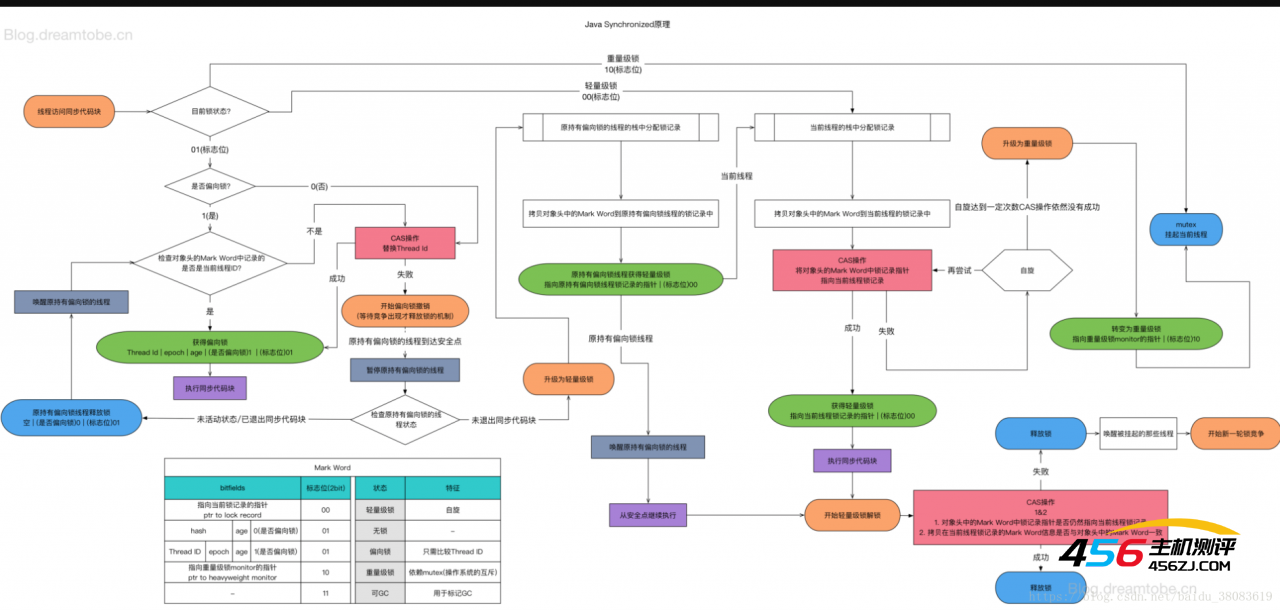
========================================================
参考:
《深入理解 Java 虚拟机》
- 海报
 456主机测评
456主机测评







